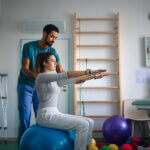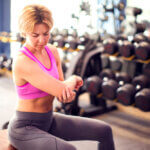Rotator cuff injuries are much more common than most people might think. In fact, rotator cuff issues led to more than 4.5 million doctor visits in 2004, and they also led to about 40,000 surgeries (UpToDate, 2019).
Physical therapy is one of the most effective options for treating rotator cuff injuries, and using therapeutic exercises recommended by a physical therapist can be especially beneficial. A National Institutes of Health (NIH) study reports that up to 80% of patients respond well to therapeutic exercises. The study also shows that patients over 65 tend to respond better to this therapy method than to surgery. Two of the therapeutic exercises your therapist might recommend for rotator cuff rehab are:
1. Doorway stretch
Stretching your shoulder is important before you move on to more challenging therapeutic exercises. There are many stretching exercises therapists can include in a rotator cuff rehab plan, and one example is the doorway stretch.
Steps for doing the doorway stretch
- Stand in a doorway and spread both arms out to the side.
- Grab onto each side of the doorway with your hands. Make sure your hands are at or slightly below shoulder height.
- Lean forward while keeping your back straight, and stop when you feel a gentle stretch in the front of your shoulders.
- Hold the stretch for 10 to 15 seconds.
- Lean back to take the pressure off your shoulders and rest for 30 seconds.
- Repeat these steps until you’ve stretched your shoulders three times.
2. Side-lying external rotation
This exercise is one of the options reviewed by the NIH study discussed above. It’s designed to help strengthen the rotator cuff muscles and improve their ability to rotate your arm outward.
Steps for doing the side-lying external rotation exercise
- Lie down on the floor or on a bed. Your affected shoulder should be facing toward the ceiling.
- Bend the elbow of the affected arm to 90 degrees. This should leave your forearm resting against your stomach.
- Hold onto a light dumbbell or soup can and slowly raise your forearm upward. Be sure to keep your elbow at your side during this movement, and stop immediately if you feel pain.
- Hold the dumbbell up for two to three seconds, and then slowly lower it back to the starting position.
- Continue to repeat these steps until you’ve done 10 repetitions. Your goals should be to do three sets of this exercise daily.
Get effective rotator cuff rehab from Peak Performance
You don’t have to rely on exercises alone when you’re going through rotator cuff rehab, and our physical therapists at Peak Performance can help you find other effective therapy options. We offer free screenings that can help you begin your therapy process. Our team also builds treatment plans that are individualized to each patient, and your plan could include therapy methods like:
- Therapeutic exercises
- Manual therapy
- Electrical stimulation
- Kinesio Taping®
- Aquatic therapy
Contact us today for more information about how we can help rotator cuff injuries or to schedule an initial appointment.







